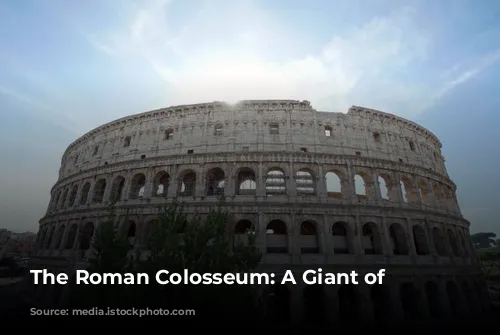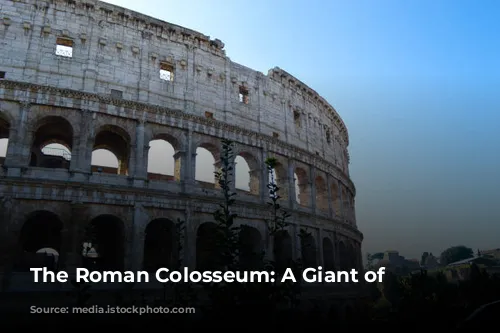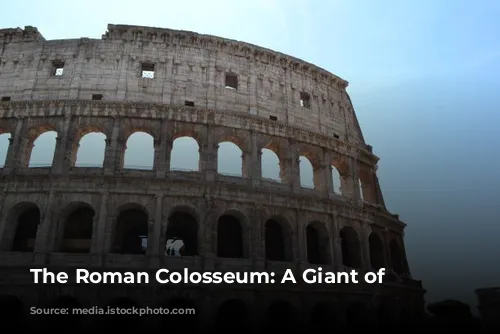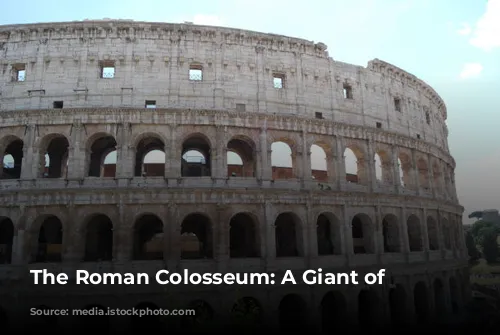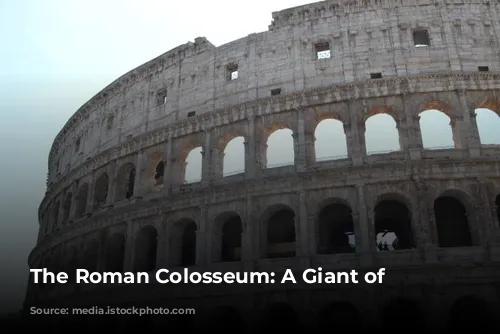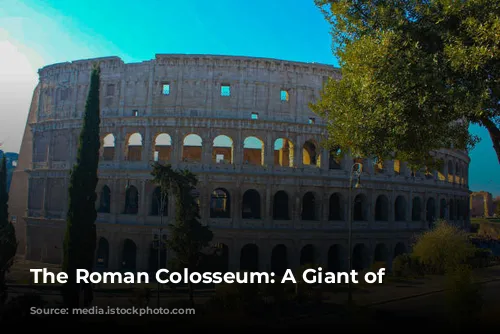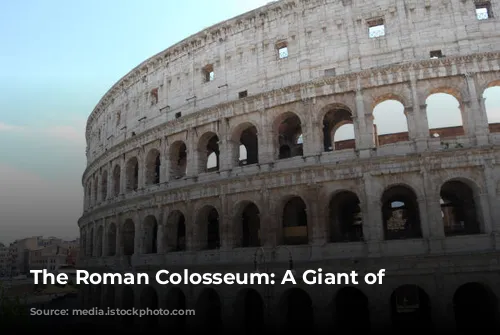The Colosseum, also known as the Flavian Amphitheatre, stands as a colossal monument to the Roman Empire. Its sheer size and imposing presence make it the largest amphitheatre ever constructed in the Roman world, and one of the most iconic landmarks in the world. This architectural marvel was the brainchild of Emperor Vespasian, a member of the Flavia family. Construction began during his reign and the amphitheatre was officially inaugurated by his son, Titus, in 80 A.D.
The grand opening of the Colosseum was a spectacle to behold, lasting an incredible 100 days. During this time, the crowds were treated to a dazzling array of events including thrilling gladiatorial combats, exotic animal hunts, and awe-inspiring naumachias – reenactments of naval battles featuring real ships on a flooded arena. Historians estimate that over 5,000 animals were slaughtered during the inaugural festivities.
The Colosseum’s Name and Structure
But why is this iconic structure called the Colosseum? Its name has its roots in a prophecy by the Venerable Bede, a medieval monk. He stated, “Rome will exist as long as the Colosseum does; when the Colosseum falls so will Rome; when Rome falls so will the world.” The name may have originated from the colossal statue of Emperor Nero, known as the “Colossus,” which stood nearby and has since vanished.
The Colosseum’s structure is a testament to Roman engineering prowess. Its elliptical shape allowed for a larger audience capacity. The imposing amphitheatre boasts four floors, each adorned with 80 arches. The upper floors were further embellished with majestic statues.
The sheer scale of the Colosseum is astounding, especially considering it was completed in a remarkable ten years. How did the Romans achieve this feat?
Roman Architectural Genius: The Arch
The Romans were masters of the arch, a key element in their architectural repertoire. Arches allowed them to distribute the weight of massive structures efficiently and effectively. The Colosseum can be viewed as a series of aqueducts stacked on top of each other, a testament to their ingenuity.
Despite its grandeur, the Colosseum today stands as a skeleton of its former glory. Sadly, the passage of time and the relentless hands of man have left three-fifths of its outer brick wall missing. The Colosseum was stripped of its valuable marble, lead, and iron in the Middle Ages, serving as a quarry for materials to build the Barberini Palace, Piazza Venezia, and even St. Peter’s Basilica.
Inside the Colosseum: Where History Came Alive
The Colosseum could accommodate up to 70,000 spectators. The tiered seating was designed to provide an excellent view of the arena from every angle. Entry was free for Roman citizens, but seating was strictly divided by social status, mirroring modern theatre seating arrangements. The upper seats were for the common folk, while the closer you were to the arena, the higher your social standing. Senators, vestals, priests, and, of course, the Emperor, occupied the coveted front row.
Just like modern sports stadiums, the Colosseum featured a sophisticated sunshade system called the “Velarium.” This massive linen canopy, suspended by ropes, winches, and wooden poles, was operated by 100 sailors from the Imperial fleet, moving in perfect harmony to the rhythm of a drum.
The arena itself, once graced with a brick and wood floor, has now vanished, revealing the cellars beneath. These cellars housed the elaborate machinery used for the games’ preparation and execution. Here, lifts and hoists, with their visible rails, were used to bring animals and gladiators into the arena with dramatic surprise effects.
The Colosseum was much more than a venue for entertainment; it was a stage for symbolic performances that forged a bond between the citizens and their leader. The games provided a much-needed distraction from political turmoil, offering a collective experience that united the people.
The Shows of the Colosseum: From Animals to Gladiators
The Colosseum hosted a diverse range of shows, each with its own designated time slot. The mornings were dedicated to “Venationes,” fierce encounters between exotic animals or between man and beast.
These events often took a gruesome turn, with criminals being thrown to their deaths at the hands of ferocious beasts. The “Silvae” must have been particularly spectacular, featuring realistic forests reconstructed in the arena, teeming with animals that weren’t always destined for a violent end.
One particularly remarkable event involved an elephant that had been trained to write words in the sand with its trunk. Contrary to popular belief, the Colosseum was not used for the mass execution of Christians.
The crowd’s favorite event was undoubtedly the gladiatorial combats. The gladiators, often prisoners of war or impoverished citizens seeking fame and fortune, were treated as heroes by their fans.
The twelve distinct types of gladiators, each with their own unique weaponry and fighting style, were chosen for their dramatic appeal. These warriors fought with a variety of weapons, including nets, tridents, knives, shields, sickles, javelins, and armor.
If a gladiator was injured, he could plead for mercy by raising his arm. The fate of the defeated warrior rested in the hands of the emperor, whose thumb up signaled a pardon, while a thumb down meant death.
The victor was showered with golden palm leaves and riches. Servants, dressed as Charon, the Ferryman of the Underworld, would ensure that the fallen gladiators were indeed dead, resorting to finishing them off if necessary.
The Legacy of the Colosseum
The Colosseum’s legacy is a complex one, reflecting the brutal reality of ancient Roman society. While modern audiences may find their shows barbaric, these spectacles mirrored the violent and often bloody world of the time.
Over time, the Colosseum fell into disuse and its walls became home to a variety of groups, including confraternities, hospitals, hermits, and even a cemetery.
In the Middle Ages, the Colosseum faced a threat of demolition, but it was ultimately declared a sacred monument dedicated to the Passion of Christ by Pope Benedict XIV. The placement of a cross on a pedestal, symbolizing the suffering of Christian martyrs, cemented its place as a symbol of Christian devotion and saved it from further destruction.
The Colosseum stands as a powerful reminder of Rome’s glorious past, attracting visitors from all corners of the world. It has become a place of pilgrimage for both Christians and history enthusiasts alike. In the words of Charles Dickens, “seeing the Colosseum means, seeing the ghost of old Rome floating over the places its people walk in.”
The Colosseum’s enduring presence is a testament to the enduring power of human ingenuity and the lasting impact of Roman civilization. It continues to inspire awe and fascination, forever serving as a reminder of the grandeur and complexity of the ancient world.
